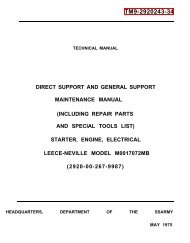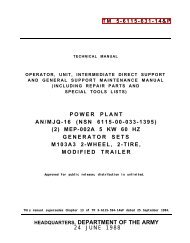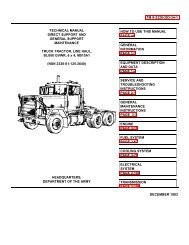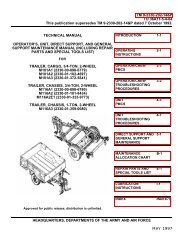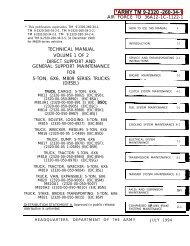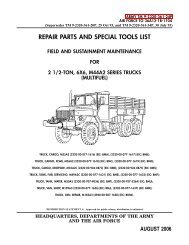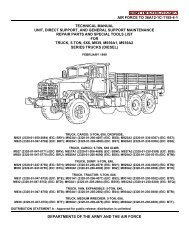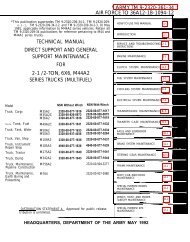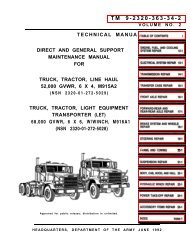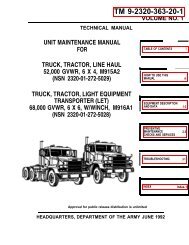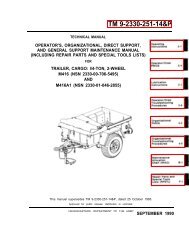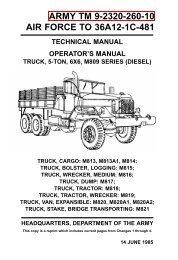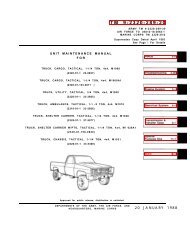- Page 1: TM 9-2815-225-34&P Supersedes copy
- Page 4 and 5: TM 9-2815-225-34&P WARNING SUMMARY
- Page 7: TM 9-2815-225-34&P *Supersedes copy
- Page 10 and 11: TM 9-2815-225-34&P TABLE OF CONTENT
- Page 12 and 13: TM 9-2815-225-34&P HOW TO USE THIS
- Page 15: TM 9-2815-225-34&P CHAPTER 1 GENERA
- Page 19 and 20: TM 9-2815-225-34&P 0001 00 DIRECT S
- Page 21: TM 9-2815-225-34&P 0001 00 GENERAL
- Page 24 and 25: TM 9-2815-225-34&P 0002 00 EQUIPMEN
- Page 26 and 27: TM 9-2815-225-34&P 0002 00 EQUIPMEN
- Page 28 and 29: TM 9-2815-225-34&P 0003 00 THEORY O
- Page 30 and 31: TM 9-2815-225-34&P 0003 00 THEORY O
- Page 32 and 33: TM 9-2815-225-34&P 0003 00 THEORY O
- Page 35: TM 9-2815-225-34&P CHAPTER 2 TROUBL
- Page 39 and 40: TM 9-2815-225-34&P 0004 00 ENGINE T
- Page 41 and 42: TM 9-2815-225-34&P 0004 00 ENGINE T
- Page 43 and 44: TM 9-2815-225-34&P 0004 00 ENGINE T
- Page 45: TM 9-2815-225-34&P CHAPTER 3 MAINTE
- Page 48 and 49: TM 9-2815-225-34&P Work Package Tit
- Page 50 and 51: TM 9-2815-225-34&P 0005 00 PREVENTI
- Page 53 and 54: TM 9-2815-225-34&P 0006 00 DIRECT S
- Page 55 and 56: TM 9-2815-225-34&P 0006 00 PREVENTI
- Page 57 and 58: TM 9-2815-225-34&P 0006 00 PREVENTI
- Page 59 and 60: TM 9-2815-225-34&P 0006 00 PREVENTI
- Page 61 and 62: TM 9-2815-225-34&P 0006 00 PREVENTI
- Page 63 and 64: TM 9-2815-225-34&P 0006 00 PREVENTI
- Page 65 and 66: TM 9-2815-225-34&P 0006 00 PREVENTI
- Page 67 and 68: TM 9-2815-225-34&P 0006 00 PREVENTI
- Page 69 and 70: TM 9-2815-225-34&P 0006 00 PREVENTI
- Page 71 and 72: TM 9-2815-225-34&P 0006 00 PREVENTI
- Page 73 and 74: TM 9-2815-225-34&P 0006 00 PREVENTI
- Page 75 and 76: TM 9-2815-225-34&P 0006 00 PREVENTI
- Page 77 and 78: TM 9-2815-225-34&P 0006 00 PREVENTI
- Page 79 and 80: TM 9-2815-225-34&P 0007 00 DIRECT S
- Page 81 and 82: TM 9-2815-225-34&P 0007 00 BIG CAM
- Page 83 and 84: TM 9-2815-225-34&P 0007 00 BIG CAM
- Page 85 and 86: TM 9-2815-225-34&P 0007 00 BIG CAM
- Page 87 and 88:
TM 9-2815-225-34&P 0007 00 BIG CAM
- Page 89:
TM 9-2815-225-34&P 0007 00 BIG CAM
- Page 92 and 93:
TM 9-2815-225-34&P 0008 00 BIG CAM
- Page 94 and 95:
TM 9-2815-225-34&P 0008 00 BIG CAM
- Page 96 and 97:
TM 9-2815-225-34&P 0008 00 BIG CAM
- Page 98 and 99:
TM 9-2815-225-34&P 0008 00 BIG CAM
- Page 100 and 101:
TM 9-2815-225-34&P 0008 00 BIG CAM
- Page 102 and 103:
TM 9-2815-225-34&P 0008 00 BIG CAM
- Page 104 and 105:
TM 9-2815-225-34&P 0008 00 BIG CAM
- Page 106 and 107:
TM 9-2815-225-34&P 0008 00 BIG CAM
- Page 108 and 109:
~ TM 9-2815-225-34&P 0008 00 BIG CA
- Page 110 and 111:
TM 9-2815-225-34&P 0008 00 BIG CAM
- Page 112 and 113:
TM 9-2815-225-34&P 0008 00 BIG CAM
- Page 114 and 115:
TM 9-2815-225-34&P 0008 00 BIG CAM
- Page 116 and 117:
TM 9-2815-225-34&P 0008 00 BIG CAM
- Page 118 and 119:
TM 9-2815-225-34&P 0008 00 BIG CAM
- Page 120 and 121:
TM 9-2815-225-34&P 0008 00 BIG CAM
- Page 123 and 124:
TM 9-2815-225-34&P 0009 00 DIRECT S
- Page 125 and 126:
TM 9-2815-225-34&P 0009 00 MOUNTING
- Page 127 and 128:
TM 9-2815-225-34&P 0009 00 MOUNTING
- Page 129:
TM 9-2815-225-34&P 0009 00 MOUNTING
- Page 132 and 133:
TM 9-2815-225-34&P 0010 00 ENGINE A
- Page 134 and 135:
TM 9-2815-225-34&P 0010 00 ENGINE A
- Page 136 and 137:
TM 9-2815-225-34&P 0010 00 ENGINE A
- Page 138 and 139:
TM 9-2815-225-34&P 0010 00 ENGINE A
- Page 140 and 141:
TM 9-2815-225-34&P 0010 00 ENGINE A
- Page 142 and 143:
TM 9-2815-225-34&P 0010 00 ENGINE A
- Page 144 and 145:
TM 9-2815-225-34&P 0010 00 ENGINE A
- Page 147 and 148:
TM 9-2815-225-34&P 0011 00 DIRECT S
- Page 149 and 150:
TM 9-2815-225-34&P 0011 00 CYLINDER
- Page 151 and 152:
TM 9-2815-225-34&P 0011 00 CYLINDER
- Page 153 and 154:
TM 9-2815-225-34&P 0012 00 DIRECT S
- Page 155 and 156:
TM 9-2815-225-34&P 0012 00 CYLINDER
- Page 157 and 158:
TM 9-2815-225-34&P 0012 00 CYLINDER
- Page 159 and 160:
TM 9-2815-225-34&P 0012 00 CYLINDER
- Page 161 and 162:
TM 9-2815-225-34&P 0013 00 DIRECT S
- Page 163 and 164:
TM 9-2815-225-34&P 0013 00 CYLINDER
- Page 165:
TM 9-2815-225-34&P 0013 00 CYLINDER
- Page 168 and 169:
TM 9-2815-225-34&P 0014 00 CYLINDER
- Page 170 and 171:
TM 9-2815-225-34&P 0014 00 CYLINDER
- Page 172 and 173:
TM 9-2815-225-34&P 0014 00 CYLINDER
- Page 174 and 175:
TM 9-2815-225-34&P 0015 00 VIBRATIO
- Page 177 and 178:
TM 9-2815-225-34&P 0016 00 DIRECT S
- Page 179 and 180:
TM 9-2815-225-34&P 0016 00 CRANKSHA
- Page 181:
TM 9-2815-225-34&P 0016 00 CRANKSHA
- Page 184 and 185:
TM 9-2815-225-34&P 0017 00 FLEXPLAT
- Page 187 and 188:
TM 9-2815-225-34&P 0018 00 DIRECT S
- Page 189 and 190:
TM 9-2815-225-34&P 0018 00 PISTONS,
- Page 191 and 192:
TM 9-2815-225-34&P 0018 00 PISTONS,
- Page 193 and 194:
TM 9-2815-225-34&P 0018 00 PISTONS,
- Page 195:
TM 9-2815-225-34&P 0018 00 PISTONS,
- Page 198 and 199:
TM 9-2815-225-34&P 0019 00 CAMSHAFT
- Page 200 and 201:
TM 9-2815-225-34&P 0019 00 CAMSHAFT
- Page 202 and 203:
TM 9-2815-225-34&P 0019 00 CAMSHAFT
- Page 204 and 205:
TM 9-2815-225-34&P 0019 00 CAMSHAFT
- Page 207 and 208:
TM 9-2815-225-34&P 0020 00 DIRECT S
- Page 209 and 210:
TM 9-2815-225-34&P 0020 00 ROCKER L
- Page 211:
TM 9-2815-225-34&P 0020 00 ROCKER L
- Page 214 and 215:
TM 9-2815-225-34&P 0021 00 OIL COOL
- Page 216 and 217:
TM 9-2815-225-34&P 0021 00 OIL COOL
- Page 218 and 219:
TM 9-2815-225-34&P 0021 00 OIL COOL
- Page 220 and 221:
TM 9-2815-225-34&P 0021 00 OIL COOL
- Page 222 and 223:
TM 9-2815-225-34&P 0021 00 OIL COOL
- Page 225 and 226:
TM 9-2815-225-34&P 0022 00 DIRECT S
- Page 227 and 228:
TM 9-2815-225-34&P 0022 00 OIL PAN,
- Page 229 and 230:
TM 9-2815-225-34&P 0022 00 OIL PAN,
- Page 231 and 232:
TM 9-2815-225-34&P 0023 00 DIRECT S
- Page 233 and 234:
TM 9-2815-225-34&P 0023 00 OIL PUMP
- Page 235 and 236:
TM 9-2815-225-34&P 0023 00 OIL PUMP
- Page 237 and 238:
TM 9-2815-225-34&P 0023 00 OIL PUMP
- Page 239:
TM 9-2815-225-34&P 0023 00 OIL PUMP
- Page 242 and 243:
TM 9-2815-225-34&P 0024 00 AIR AFTE
- Page 244 and 245:
TM 9-2815-225-34&P 0024 00 AIR AFTE
- Page 247 and 248:
TM 9-2815-225-34&P 0025 00 DIRECT S
- Page 249 and 250:
TM 9-2815-225-34&P 0025 00 EXHAUST
- Page 251:
TM 9-2815-225-34&P 0025 00 EXHAUST
- Page 254 and 255:
TM 9-2815-225-34&P 0026 00 TURBOCHA
- Page 256 and 257:
TM 9-2815-225-34&P 0026 00 TURBOCHA
- Page 258 and 259:
TM 9-2815-225-34&P 0026 00 TURBOCHA
- Page 261 and 262:
TM 9-2815-225-34&P 0027 00 DIRECT S
- Page 263 and 264:
11 11 TM 9-2815-225-34&P 0027 00 TU
- Page 265 and 266:
TM 9-2815-225-34&P 0027 00 TURBOCHA
- Page 267:
TM 9-2815-225-34&P 0027 00 TURBOCHA
- Page 270 and 271:
TM 9-2815-225-34&P 0028 00 FRONT GE
- Page 272 and 273:
TM 9-2815-225-34&P 0028 00 FRONT GE
- Page 274 and 275:
TM 9-2815-225-34&P 0029 00 ACCESSOR
- Page 276 and 277:
TM 9-2815-225-34&P 0029 00 ACCESSOR
- Page 279 and 280:
TM 9-2815-225-34&P 0030 00 DIRECT S
- Page 281 and 282:
TM 9-2815-225-34&P 0030 00 ENGINE R
- Page 283:
TM 9-2815-225-34&P 0030 00 ENGINE R
- Page 286 and 287:
TM 9-2815-225-34&P 0031 00 AIR COMP
- Page 288 and 289:
TM 9-2815-225-34&P 0031 00 AIR COMP
- Page 290 and 291:
TM 9-2815-225-34&P 0031 00 AIR COMP
- Page 292 and 293:
TM 9-2815-225-34&P 0031 00 AIR COMP
- Page 294 and 295:
TM 9-2815-225-34&P 0031 00 AIR COMP
- Page 296 and 297:
TM 9-2815-225-34&P 0032 00 FUEL INJ
- Page 298 and 299:
TM 9-2815-225-34&P 0032 00 FUEL INJ
- Page 301 and 302:
TM 9-2815-225-34&P 0033 00 DIRECT S
- Page 303 and 304:
TM 9-2815-225-34&P 0033 00 FUEL PUM
- Page 305 and 306:
TM 9-2815-225-34&P 0033 00 FUEL PUM
- Page 307:
TM 9-2815-225-34&P 0033 00 FUEL PUM
- Page 310 and 311:
TM 9-2815-225-34&P 0034 00 SOLENOID
- Page 313 and 314:
TM 9-2815-225-34&P 0035 00 DIRECT S
- Page 315:
TM 9-2815-225-34&P 0035 00 FUEL DAM
- Page 318 and 319:
TM 9-2815-225-34&P 0036 00 FUEL GEA
- Page 320 and 321:
TM 9-2815-225-34&P 0036 00 FUEL GEA
- Page 322 and 323:
TM 9-2815-225-34&P 0036 00 FUEL GEA
- Page 325 and 326:
TM 9-2815-225-34&P 0037 00 DIRECT S
- Page 327:
TM 9-2815-225-34&P 0037 00 FUEL PUM
- Page 330 and 331:
TM 9-2815-225-34&P 0038 00 FUEL PUM
- Page 332 and 333:
TM 9-2815-225-34&P 0038 00 FUEL PUM
- Page 335 and 336:
TM 9-2815-225-34&P 0039 00 DIRECT S
- Page 337 and 338:
TM 9-2815-225-34&P 0039 00 FUEL PUM
- Page 339:
TM 9-2815-225-34&P 0039 00 FUEL PUM
- Page 342 and 343:
TM 9-2815-225-34&P 0040 00 FUEL PUM
- Page 344 and 345:
TM 9-2815-225-34&P 0040 00 FUEL PUM
- Page 347 and 348:
TM 9-2815-225-34&P 0041 00 DIRECT S
- Page 349 and 350:
TM 9-2815-225-34&P 0041 00 WATER PU
- Page 351 and 352:
TM 9-2815-225-34&P 0041 00 WATER PU
- Page 353:
TM 9-2815-225-34&P 0041 00 WATER PU
- Page 356 and 357:
TM 9-2815-225-34&P 0042 00 CYLINDER
- Page 358 and 359:
TM 9-2815-225-34&P 0042 00 CYLINDER
- Page 360 and 361:
TM 9-2815-225-34&P 0042 00 CYLINDER
- Page 362 and 363:
TM 9-2815-225-34&P 0042 00 CYLINDER
- Page 364 and 365:
TM 9-2815-225-34&P 0042 00 CYLINDER
- Page 366 and 367:
TM 9-2815-225-34&P 0042 00 CYLINDER
- Page 368 and 369:
TM 9-2815-225-34&P 0042 00 CYLINDER
- Page 370 and 371:
TM 9-2815-225-34&P 0042 00 CYLINDER
- Page 372 and 373:
TM 9-2815-225-34&P 0042 00 CYLINDER
- Page 374 and 375:
TM 9-2815-225-34&P 0042 00 CYLINDER
- Page 376 and 377:
TM 9-2815-225-34&P 0042 00 CYLINDER
- Page 378 and 379:
TM 9-2815-225-34&P 0042 00 CYLINDER
- Page 380 and 381:
TM 9-2815-225-34&P 0042 00 CYLINDER
- Page 382 and 383:
TM 9-2815-225-34&P 0042 00 CYLINDER
- Page 385 and 386:
TM 9-2815-225-34&P 0043 00 DIRECT S
- Page 387 and 388:
TM 9-2815-225-34&P 0043 00 CYLINDER
- Page 389 and 390:
TM 9-2815-225-34&P 0043 00 CYLINDER
- Page 391 and 392:
TM 9-2815-225-34&P 0043 00 CYLINDER
- Page 393 and 394:
TM 9-2815-225-34&P 0043 00 CYLINDER
- Page 395 and 396:
TM 9-2815-225-34&P 0044 00 DIRECT S
- Page 397 and 398:
TM 9-2815-225-34&P 0044 00 FUEL PUM
- Page 399 and 400:
TM 9-2815-225-34&P 0044 00 FUEL PUM
- Page 401 and 402:
TM 9-2815-225-34&P 0044 00 FUEL PUM
- Page 403:
TM 9-2815-225-34&P 0044 00 FUEL PUM
- Page 406 and 407:
TM 9-2815-225-34&P 0045 00 ENGINE A
- Page 408 and 409:
TM 9-2815-225-34&P 0045 00 ENGINE A
- Page 410 and 411:
TM 9-2815-225-34&P 0045 00 ENGINE A
- Page 412 and 413:
TM 9-2815-225-34&P 0045 00 ENGINE A
- Page 414 and 415:
TM 9-2815-225-34&P 0046 00 REMOVING
- Page 416 and 417:
TM 9-2815-225-34&P 0046 00 REMOVING
- Page 418 and 419:
TM 9-2815-225-34&P 0046 00 REMOVING
- Page 420 and 421:
TM 9-2815-225-34&P 0046 00 REMOVING
- Page 422 and 423:
TM 9-2815-225-34&P 0046 00 REMOVING
- Page 425 and 426:
TM 9-2815-225-34&P 0047 00 DIRECT S
- Page 427 and 428:
TM 9-2815-225-34&P 0047 00 ENGINE T
- Page 429 and 430:
TM 9-2815-225-34&P 0047 00 ENGINE T
- Page 431 and 432:
TM 9-2815-225-34&P 0047 00 ENGINE T
- Page 433:
TM 9-2815-225-34&P 0047 00 ENGINE T
- Page 436 and 437:
TM 9-2815-225-34&P 0048 00 BIG CAM
- Page 438 and 439:
TM 9-2815-225-34&P 0048 00 BIG CAM
- Page 440 and 441:
TM 9-2815-225-34&P 0048 00 BIG CAM
- Page 442 and 443:
TM 9-2815-225-34&P 0048 00 BIG CAM
- Page 444 and 445:
TM 9-2815-225-34&P 0048 00 BIG CAM
- Page 446 and 447:
TM 9-2815-225-34&P 0048 00 BIG CAM
- Page 448 and 449:
TM 9-2815-225-34&P 0048 00 BIG CAM
- Page 450 and 451:
TM 9-2815-225-34&P 0048 00 BIG CAM
- Page 452 and 453:
TM 9-2815-225-34&P 0048 00 BIG CAM
- Page 454 and 455:
TM 9-2815-225-34&P 0048 00 BIG CAM
- Page 456 and 457:
TM 9-2815-225-34&P 0048 00 BIG CAM
- Page 458 and 459:
TM 9-2815-225-34&P 0048 00 BIG CAM
- Page 460 and 461:
TM 9-2815-225-34&P 0048 00 BIG CAM
- Page 462 and 463:
TM 9-2815-225-34&P 0048 00 BIG CAM
- Page 464 and 465:
TM 9-2815-225-34&P 0049 00 BIG CAM
- Page 466 and 467:
TM 9-2815-225-34&P 0049 00 BIG CAM
- Page 468 and 469:
TM 9-2815-225-34&P 0049 00 BIG CAM
- Page 470 and 471:
TM 9-2815-225-34&P 0049 00 BIG CAM
- Page 472 and 473:
TM 9-2815-225-34&P 0049 00 BIG CAM
- Page 475 and 476:
TM 9-2815-225-34&P 0050 00 DIRECT S
- Page 477 and 478:
TM 9-2815-225-34&P 0050 00 BIG CAM
- Page 479:
TM 9-2815-225-34&P 0050 00 BIG CAM
- Page 482 and 483:
TM 9-2815-225-34&P 0051 00 GENERAL
- Page 484 and 485:
TM 9-2815-225-34&P 0051 00 GENERAL
- Page 486 and 487:
TM 9-2815-225-34&P 0051 00 GENERAL
- Page 489 and 490:
TM 9-2815-225-34&P 0052 00 DIRECT S
- Page 491 and 492:
TM 9-2815-225-34&P 0052 00 ILLUSTRA
- Page 493 and 494:
TM 9-2815-225-34&P 0053 00 DIRECT S
- Page 495 and 496:
TM 9-2815-225-34&P 0053 00 TORQUE L
- Page 497 and 498:
TM 9-2815-225-34&P 0053 00 TORQUE L
- Page 499 and 500:
TM 9-2815-225-34&P 0053 00 TORQUE L
- Page 501:
TM 9-2815-225-34&P 0053 00 TORQUE L
- Page 504 and 505:
TM 9-2815-225-34&P 0054 00 WEAR LIM
- Page 506 and 507:
TM 9-2815-225-34&P 0054 00 WEAR LIM
- Page 508 and 509:
TM 9-2815-225-34&P 0054 00 WEAR LIM
- Page 511:
TM 9-2815-225-34&P CHAPTER 4 SUPPOR
- Page 514 and 515:
TM 9-2815-225-34&P 0055 00 REFERENC
- Page 516 and 517:
TM 9-2815-225-34&P 0056 00 REPAIR P
- Page 518 and 519:
TM 9-2815-225-34&P 0056 00 REPAIR P
- Page 520 and 521:
TM 9-2815-225-34&P 0057 00 TABLE OF
- Page 522 and 523:
TM 9-2815-225-34&P 1 2 thru 10 2 3
- Page 524 and 525:
TM 9-2815-225-34&P Figure 2. Engine
- Page 526:
TM 9-2815-225-34&P (1) Item NO (2)
- Page 529 and 530:
TM 9-2815-225-34&P (1) ITEM NO (2)
- Page 531 and 532:
TM 9-2815-225-34&P (1) ITEM NO (2)
- Page 533 and 534:
TM 9-2815-225-34&P (1) ITEM NO (2)
- Page 535 and 536:
TM 9-2815-225-34&P (1) ITEM NO (2)
- Page 537 and 538:
TM 9-2815-225-34&P (1) ITEM NO (2)
- Page 540 and 541:
TM 9-2815-225-34&P 1 2 thru 30 2 3
- Page 542 and 543:
TM 9-2815-225-34&P 2 5 7 1 2 4 7 2
- Page 544 and 545:
TM 9-2815-225-34&P 1 2 thru 29 46 2
- Page 546 and 547:
TM 9-2815-225-34&P 11 12 thru 35 27
- Page 548 and 549:
TM 9-2815-225-34&P 2 3 thru 12 1 4
- Page 550:
TM 9-2815-225-34&P (1) Item NO (2)
- Page 553 and 554:
TM 9-2815-225-34&P (1) ITEM NO (2)
- Page 556 and 557:
TM 9-2815-225-34&P Figure 14. Air A
- Page 558:
TM 9-2815-225-34&P (1) ITEM NO (2)
- Page 561 and 562:
TM 9-2815-225-34&P (1) ITEM NO (2)
- Page 563 and 564:
TM 9-2815-225-34&P (1) ITEM NO (2)
- Page 565 and 566:
TM 9-2815-225-34&P (1) ITEM NO (2)
- Page 567 and 568:
TM 9-2815-225-34&P (1) ITEM NO (2)
- Page 569:
TM 9-2815-225-34&P (1) ITEM NO (2)
- Page 572 and 573:
TM 9-2815-225-34&P 57 56 55 54 58 F
- Page 574:
TM 9-2815-225-34&P (1) ITEM NO (2)
- Page 577 and 578:
(1) ITEM NO (2) SMR CODE (3) NSN (4
- Page 579 and 580:
TM 9-2815-225-34&P (1) ITEM NO (2)
- Page 581 and 582:
TM 9-2815-225-34&P (1) ITEM NO (2)
- Page 583 and 584:
TM 9-2815-225-34&P (1) ITEM NO (2)
- Page 586 and 587:
TM 9-2815-225-34&P 1 2 thru 19 3 4
- Page 588 and 589:
TM 9-2815-225-34&P 20 21 22 23 and
- Page 590 and 591:
TM 9-2815-225-34&P 1 2 3 4 5 6 7 8
- Page 592 and 593:
1 28 9 TM 9-2815-225-34&P 3 2 4 5 6
- Page 594 and 595:
TM 9-2815-225-34&P 4 5 thru 17 1 2
- Page 596 and 597:
TM 9-2815-225-34&P 1 2 thru 29 48 4
- Page 598:
TM 9-2815-225-34&P (1) ITEM NO (2)
- Page 601 and 602:
TM 9-2815-225-34&P (1) ITEM NO (2)
- Page 603 and 604:
TM 9-2815-225-34&P (1) ITEM NO (2)
- Page 605 and 606:
TM 9-2815-225-34&P (1) ITEM NO (2)
- Page 607 and 608:
TM 9-2815-225-34&P (1) ITEM NO (2)
- Page 609 and 610:
TM 9-2815-225-34&P (1) ITEM NO (2)
- Page 611:
TM 9-2815-225-34&P (1) ITEM NO (2)
- Page 614 and 615:
TM 9-2815-225-34&P (1) ITEM NO (2)
- Page 617 and 618:
TM 9-2815-225-34&P (1) ITEM NO (2)
- Page 619 and 620:
TM 9-2815-225-34&P (1) ITEM NO (2)
- Page 621 and 622:
TM 9-2815-225-34&P (1) ITEM NO (2)
- Page 623:
TM 9-2815-225-34&P (1) ITEM NO (2)
- Page 626 and 627:
TM 9-2815-225-34&P 16 17 thru 20 21
- Page 628 and 629:
TM 9-2815-225-34&P 4 5 7 8 thru 12
- Page 630 and 631:
TM 9-2815-225-34&P 1 2 3 4 7 6 5 Fi
- Page 632 and 633:
TM 9-2815-225-34&P 1 2 thru 8 9 10
- Page 634 and 635:
TM 9-2815-225-34&P 1 2 thru 10 12 1
- Page 636 and 637:
TM 9-2815-225-34&P 1 2 3 thru 13 14
- Page 638 and 639:
TM 9-2815-225-34&P 4 5 and 6 1 2 8
- Page 640 and 641:
TM 9-2815-225-34&P 1 2 9 8 3 4 7 6
- Page 642 and 643:
TM 9-2815-225-34&P 1 2 3 10 4 9 5 8
- Page 644 and 645:
TM 9-2815-225-34&P 1 2 3 4 11 5 10
- Page 646 and 647:
TM 9-2815-225-34&P 1 2 3 8 4 7 6 5
- Page 648 and 649:
TM 9-2815-225-34&P 1 2 3 8 4 7 6 5
- Page 650 and 651:
TM 9-2815-225-34&P 1 2 3 6 4 5 Figu
- Page 652 and 653:
TM 9-2815-225-34&P 1 2 3 4 5 Figure
- Page 655:
TM 9-2815-225-34&P 0059 00 DIRECT S
- Page 658 and 659:
TM9-2815-225-34&P CROSS REFERENCE I
- Page 660 and 661:
TM9-2815-225-34&P CROSS REFERENCE I
- Page 662 and 663:
TM9-2815-225-34&P CROSS REFERENCE I
- Page 664 and 665:
TM9-2815-225-34&P CROSS REFERENCE I
- Page 666 and 667:
TM9-2815-225-34&P CROSS REFERENCE I
- Page 668 and 669:
TM9-2815-225-34&P CROSS REFERENCE I
- Page 670 and 671:
TM9-2815-225-34&P CROSS REFERENCE I
- Page 672 and 673:
TM9-2815-225-34&P CROSS REFERENCE I
- Page 674 and 675:
TM9-2815-225-34&P CROSS REFERENCE I
- Page 676 and 677:
TM9-2815-225-34&P CROSS REFERENCE I
- Page 678 and 679:
TM9-2815-225-34&P CROSS REFERENCE I
- Page 680 and 681:
TM9-2815-225-34&P CROSS REFERENCE I
- Page 682 and 683:
TM9-2815-225-34&P CROSS REFERENCE I
- Page 684 and 685:
TM9-2815-225-34&P CROSS REFERENCE I
- Page 686 and 687:
TM9-2815-225-34&P CROSS REFERENCE I
- Page 688 and 689:
TM9-2815-225-34&P CROSS REFERENCE I
- Page 690 and 691:
TM9-2815-225-34&P CROSS REFERENCE I
- Page 692 and 693:
TM9-2815-225-34&P CROSS REFERENCE I
- Page 695 and 696:
TM 9-2815-225-34&P 0060 00 DIRECT S
- Page 697 and 698:
TM 9-2815-225-34&P 0060 00 EXPENDAB
- Page 699 and 700:
TM 9-2815-225-34&P 0061 00 DIRECT S
- Page 701 and 702:
TM 9-2815-225-34&P 0061 00 TOOLS AN
- Page 703 and 704:
TM 9-2815-225-34&P 0062 00 DIRECT S
- Page 705 and 706:
TM 9-2815-225-34&P 0062 00 MANDATOR
- Page 707 and 708:
TM 9-2815-225-34&P 0062 00 MANDATOR
- Page 709 and 710:
TM 9-2815-225-34&P 0062 00 MANDATOR
- Page 711 and 712:
TM 9-2815-225-34&P 0062 00 MANDATOR
- Page 713 and 714:
TM 9-2815-225-34&P 0062 00 MANDATOR
- Page 715 and 716:
TM 9-2815-225-34&P 0062 00 MANDATOR
- Page 717 and 718:
TM 9-2815-225-34&P 0062 00 MANDATOR
- Page 719 and 720:
TM 9-2815-225-34&P INDEX Subject WP
- Page 721:
TM 9-2815-225-34&P INDEX (Contd) Su
- Page 724 and 725:
TO: (Forward direct to addressee li
- Page 726 and 727:
TO: (Forward direct to addressee li
- Page 728 and 729:
TO: (Forward direct to addressee li
- Page 730 and 731:
TO: (Forward direct to addressee li
- Page 735 and 736:
THE METRIC SYSTEM AND EQUIVALENTS L



